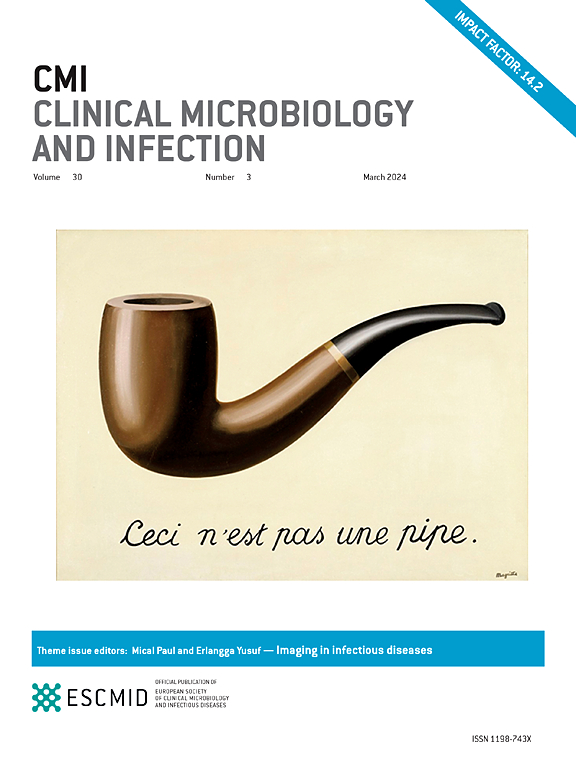新加坡老年人接受 Nirmatrelvir/ritonavir 治疗与 COVID-19 后遗症的风险。
IF 10.9
1区 医学
Q1 INFECTIOUS DISEASES
引用次数: 0
摘要
研究目的:在评估早期口服抗病毒治疗对预防 COVID-19 (PASC) 后急性后遗症的影响的队列研究中,存在明显的异质性。我们评估了早期尼马瑞韦/利托那韦对新加坡老年人急性期后心血管、神经、呼吸和自身免疫诊断风险以及急性期后症状的影响:方法:利用国家 COVID-19 登记和医疗保健索赔数据库构建了一个基于人群的回顾性队列,纳入了所有在 Omicron 传播期间(2022 年 3 月 18 日至 2023 年 8 月 4 日)在初级保健机构确诊感染 SARS-CoV-2 的年龄≥60 岁的新加坡人。人群分为接受过尼马瑞韦/利托那韦治疗组和未接受治疗组。组间基线特征差异采用重叠加权法进行调整。采用竞争风险回归法(根据人口统计学特征/疫苗接种状况/并发症进行调整)对治疗组/未治疗组感染 SARS-CoV-2 后急性心血管、神经、呼吸系统和自身免疫诊断的风险以及急性期后症状(31-180 天)进行对比:共纳入 188,532 名新加坡老年人,其中 5.8%(10,905/188,532)接受了尼马瑞韦/利托那韦治疗。急性期后遗症的风险没有明显降低(任何后遗症:调整后危险比,aHR=1.06[0.94-1.19];心血管后遗症:aHR=1.01[0.83-1.24];神经系统后遗症:aHR=1.09[0.95-1.27];呼吸系统后遗症:aHR=1.与未经治疗的病例相比,接受过尼马瑞韦/利托那韦治疗的病例在感染后 180 天内观察到的后遗症包括:神经系统后遗症:aHR=1.01[0.83-1.24];呼吸系统后遗症:aHR=1.09[0.95-1.27];自身免疫后遗症:aHR=1.14[0.84-1.55];自身免疫后遗症:aHR=0.76[0.53-1.09]或任何急性后症状:aHR=0.97[0.80-1.18])。在所有疫苗接种和年龄亚组中,均未观察到感染后180天内任何急性诊断/症状或任何心血管、神经、呼吸和自身免疫并发症的风险明显降低:结论:早期门诊接受尼马瑞韦/利托那韦治疗并不能显著降低急性期后心血管、神经系统、呼吸系统和自身免疫后遗症的风险,也不能显著降低新加坡老年人队列中急性期后症状的风险。本文章由计算机程序翻译,如有差异,请以英文原文为准。
Nirmatrelvir/ritonavir treatment and risk for postacute sequelae of COVID-19 in older Singaporeans
Objectives
Significant heterogeneity has been reported in cohort studies evaluating the impact of early oral antiviral treatment on preventing postacute sequelae after COVID-19. We evaluated the impact of early nirmatrelvir/ritonavir on risk of postacute cardiovascular, neurological, respiratory, and autoimmune diagnoses, as well as postacute symptoms amongst older Singaporeans.
Methods
National COVID-19 registries and healthcare claims databases were used to construct a retrospective population-based cohort enrolling all Singaporeans aged ≥60 years diagnosed with SARS-CoV-2 infection in primary care during Omicron transmission (18 March 2022–4 August 2023). The cohort was divided into nirmatrelvir/ritonavir-treated and untreated groups. Between-group differences in baseline characteristics were adjusted using overlap weighting. Risks of postacute cardiovascular, neurological, respiratory, and autoimmune diagnoses and postacute symptoms (31–180 days) after SARS-CoV-2 infection were contrasted in treated/untreated groups using competing risks regressions (adjusted for demographics/vaccination status/comorbidities).
Results
A total of 188 532 older Singaporeans were included; 5.8% (10 905/188 532) received nirmatrelvir/ritonavir. No significantly decreased risk of postacute sequelae (any sequelae: adjusted hazards ratio [aHR], 1.06; 0.94–1.19; cardiovascular sequelae: aHR, 1.01; 0.83–1.24; neurological sequelae: aHR, 1.09; 0.95–1.27; respiratory sequelae: aHR, 1.14; 0.84–1.55; autoimmune sequelae: aHR, 0.76; 0.53–1.09; or any postacute symptom: aHR, 0.97; 0.80–1.18) was observed up to 180 days post-infection in nirmatrelvir/ritonavir-treated individuals vs. untreated cases. Across all vaccination and age subgroups, no significantly decreased risk of any postacute diagnosis/symptom or any cardiovascular, neurological, respiratory, and autoimmune complications up to 180 days post-infection was observed.
Discussion
Early outpatient receipt of nirmatrelvir/ritonavir did not significantly reduce risk of postacute cardiovascular, neurological, respiratory, and autoimmune sequelae or the risk of postacute symptoms in a boosted cohort of older Singaporeans.
求助全文
通过发布文献求助,成功后即可免费获取论文全文。
去求助
来源期刊
CiteScore
25.30
自引率
2.10%
发文量
441
审稿时长
2-4 weeks
期刊介绍:
Clinical Microbiology and Infection (CMI) is a monthly journal published by the European Society of Clinical Microbiology and Infectious Diseases. It focuses on peer-reviewed papers covering basic and applied research in microbiology, infectious diseases, virology, parasitology, immunology, and epidemiology as they relate to therapy and diagnostics.

 求助内容:
求助内容: 应助结果提醒方式:
应助结果提醒方式:


